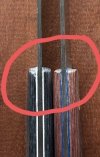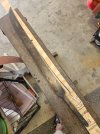-
The BladeForums.com 2024 Traditional Knife is available! Price is $250 ea (shipped within CONUS).
Order here: https://www.bladeforums.com/help/2024-traditional/
You are using an out of date browser. It may not display this or other websites correctly.
You should upgrade or use an alternative browser.
You should upgrade or use an alternative browser.
What's going on in your shop? Show us whats going on, and talk a bit about your work!
- Thread starter WillSwift
- Start date
Forrest Taylor
Knifemaker / Craftsman / Service Provider
- Joined
- May 13, 2021
- Messages
- 366
Just finished these twin hunters.
OAL - 8.5” Edge - 4.5”
.09” 14C28N RC ~63 HT by Paul Bos
Dymalux handles - Cocobolo and Charcoal w/ fiber liners
Loveless style bolts and GFlex epoxy
Just need to make sheaths and put on final edge.

Once the scales are glued to the tang this area is next to impossible to finish without affecting the choil.
I'm by no means an expert and I'm certain someone will offer up a better method but here's what I do.
To get this end of both scales completely finished and lined up with each other I like to clamp the tang to one scale, mark the scale using the tang as a template to get an outside line to grind to so I can remove excess material later.
I then drill one pin hole through the pre-drilled tang and scale, usually the one closest to the choil. Next I remove the clamp and rough grind the scale profile closer to the line I marked just to remove extra material. Afterwards I clamp the two scales together and drill the pin hole through the other scale. Then I have a pin hole through both scales. A couple of small pieces of double stick tape and a pin inserted into the hole and I can grind the scales as one piece . I completely finish the end of the scales closest to the choil. I like to rough grind both scales so the profiles are the same. That way when gluing I can line the scales up at the pommel and know the choil end is lined up.
I insert the one pin when gluing the tang to the first scale and then drill the other holes after it cures. The second scale gets glued and slipped on the pin, the pommel end lined up, clamped, and lightly peened.
The overlap of the scales around the tang isn't overly important at this point as it will get ground off after gluing both scales on.
Then after it cures, flip it over and drill the remaining pin holes. The last pins are dipped in glue, inserted in the holes, and lightly peened.
The handle is ready for finishing.
You can just double stick tape the scales together and then grind and finish the choil end, but I found it's harder to have the scales lined up exactly where I want it on the tang and lined up with the other one without the pin as a reference point.
Last edited:
I stack up the handle material scales, put the blade over them and then clamp all three pieces together. Then I drill my pinholes and add the pins. Then I Trace around the Tang and cut out the scales to the rough shape, including the front. With the pins still in the handle material, I shape and polish the whole front end of the handles before they ever go on the blade.
ScarFoot
Knifemaker / Craftsman / Service Provider
- Joined
- Sep 16, 2021
- Messages
- 857
This is the way.I stack up the handle material scales, put the blade over them and then clamp all three pieces together. Then I drill my pinholes and add the pins. Then I Trace around the Tang and cut out the scales to the rough shape, including the front. With the pins still in the handle material, I shape and polish the whole front end of the handles before they ever go on the blade.
J Lensmire
Knifemaker / Craftsman / Service Provider
- Joined
- Oct 30, 2021
- Messages
- 229
Thanks for the tips. Always looking to improve. With these two the biggest factor was excess epoxy and the clean up of it. I still haven’t found a way, to my liking, of handling excess glue in this area. Sometimes tape works, I’ve tried wiping excess off but still leaves a film. I’m afraid of removing excess with alcohol/acetone while it’s setting up, due to possible harm to glue adhesion to handle slab/blade. Always a work in progress. Thanks again.
J Lensmire
Knifemaker / Craftsman / Service Provider
- Joined
- Oct 30, 2021
- Messages
- 229
I’ve recently sharpened a piece of G10 liner to use as scraper which seems to be working well. These two got away from me. I have to pay more attention at final fit. Thanks all!
- Joined
- Sep 12, 2007
- Messages
- 338
Thank you. This one was ground pre-HT. I had the same thought about some surface degradation, but I send my knives for HT to a professional facility that uses vacuum ovens, so I figured it is more likely my lack of skill rather than decarb or such. But I have another knife that I had to straighten and then grind a little post-HT, so I will try to see if the issue persists there as well.Are you grinding pre or post heat treat and are you heat treating them yourself? Any potential decarb/scale issue? I haven’t used that steel before but it doesn’t seem like grit should matter. Great looking knife by the way.
When I tried to find someone who had trouble finishing vanadium steels, I found this thread - https://www.bladeforums.com/threads/s30v-hand-sanding-issues.826528/ - where the first post exactly described what I was experiencing: smooth sailing up to 400, very difficult afterward.
Forrest Taylor
Knifemaker / Craftsman / Service Provider
- Joined
- May 13, 2021
- Messages
- 366
I've done it that way, but occasionally ran into problems if the scales weren't uniform thickness. Mostly with wood, micarta is the same thicknessThis is the way.
Forrest Taylor
Knifemaker / Craftsman / Service Provider
- Joined
- May 13, 2021
- Messages
- 366
Q-Tips and alcohol. Shake off excess.Thanks for the tips. Always looking to improve. With these two the biggest factor was excess epoxy and the clean up of it. I still haven’t found a way, to my liking, of handling excess glue in this area. Sometimes tape works, I’ve tried wiping excess off but still leaves a film. I’m afraid of removing excess with alcohol/acetone while it’s setting up, due to possible harm to glue adhesion to handle slab/blade. Always a work in progress. Thanks again.
ScarFoot
Knifemaker / Craftsman / Service Provider
- Joined
- Sep 16, 2021
- Messages
- 857
This too is the way.Q-Tips and alcohol. Shake off excess.
ScarFoot
Knifemaker / Craftsman / Service Provider
- Joined
- Sep 16, 2021
- Messages
- 857
Understood. I used to have that problem but now I stick rough cut wood pieces on my SGA with double sided tape and even them up before I use them.I've done it that way, but occasionally ran into problems if the scales weren't uniform thickness. Mostly with wood, micarta is the same thickness
ScarFoot
Knifemaker / Craftsman / Service Provider
- Joined
- Sep 16, 2021
- Messages
- 857
What epoxy do you use? It helps to use something with a longer set/cure time if you aren’t already. Myself and every maker I’ve ever talked to used either alcohol or acetone on q-tips to clean that area up and I haven’t heard of anyone having trouble. They both evaporate so quickly I’d say the risk is minimal. I removed the handles of one of the knives I made using that cleanup method and essentially had to burn the g10 liners off of the tang with a torch. I use G-flex epoxy by the way.Thanks for the tips. Always looking to improve. With these two the biggest factor was excess epoxy and the clean up of it. I still haven’t found a way, to my liking, of handling excess glue in this area. Sometimes tape works, I’ve tried wiping excess off but still leaves a film. I’m afraid of removing excess with alcohol/acetone while it’s setting up, due to possible harm to glue adhesion to handle slab/blade. Always a work in progress. Thanks again.
I use pointed q tips which work really well. It has a standard tip on one end, a pointed one on the otherWhat epoxy do you use? It helps to use something with a longer set/cure time if you aren’t already. Myself and every maker I’ve ever talked to used either alcohol or acetone on q-tips to clean that area up and I haven’t heard of anyone having trouble. They both evaporate so quickly I’d say the risk is minimal. I removed the handles of one of the knives I made using that cleanup method and essentially had to burn the g10 liners off of the tang with a torch. I use G-flex epoxy by the way.
Hengelo_77
Basic Member
- Joined
- Mar 2, 2006
- Messages
- 6,279
G10 is glass and scratches hardened steel (guess how I found out)I’ve recently sharpened a piece of G10 liner to use as scraper which seems to be working well. These two got away from me. I have to pay more attention at final fit. Thanks all!
I scrape with brass or aluminium
Hengelo_77
Basic Member
- Joined
- Mar 2, 2006
- Messages
- 6,279
Having fun with diamond bits in my pantograph.
Apparently "Oil the joint(s)" was a thing with classic slipjoints.


Apparently "Oil the joint(s)" was a thing with classic slipjoints.


oldschool45
Gold Member
- Joined
- Oct 15, 2007
- Messages
- 1,231
J Lensmire
Knifemaker / Craftsman / Service Provider
- Joined
- Oct 30, 2021
- Messages
- 229
I use GFlex also. My experience with alcohol/acetone clean-up has to do with my work. I work on medical/ophthalmic lasers. I’ve had alcohol/acetone migrate into places that caused issues with bonding etc. Obviously, amount of surface area glued comes into play. I’ll definitely start the alcohol clean up to save trouble down the road. Thanks againWhat epoxy do you use? It helps to use something with a longer set/cure time if you aren’t already. Myself and every maker I’ve ever talked to used either alcohol or acetone on q-tips to clean that area up and I haven’t heard of anyone having trouble. They both evaporate so quickly I’d say the risk is minimal. I removed the handles of one of the knives I made using that cleanup method and essentially had to burn the g10 liners off of the tang with a torch. I use G-flex epoxy by the way.
ScarFoot
Knifemaker / Craftsman / Service Provider
- Joined
- Sep 16, 2021
- Messages
- 857
Makes sense. I used one damp q-tip and a shop towel to clean up 4 knives I glued yesterday so it really doesn’t take much. The instructions for G/flex 650 call out using a citrus based cleaner, acetone or lacquer thinner to clean up epoxy residue. I’d probably avoid citrus based as it might etch/oxidize the metal.I use GFlex also. My experience with alcohol/acetone clean-up has to do with my work. I work on medical/ophthalmic lasers. I’ve had alcohol/acetone migrate into places that caused issues with bonding etc. Obviously, amount of surface area glued comes into play. I’ll definitely start the alcohol clean up to save trouble down the road. Thanks again

